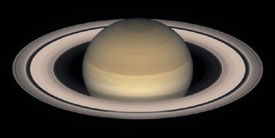
Acquired in November 2000 by the Hubble Space Telescope, this image shows Saturn and its rings in all their glory. The planet's spin axis is tipped 27° with respect to its orbit. South is up to match the view in an astronomical (inverting) telescope. Click on the image for a larger view.
Courtesy NASA and the Hubble Heritage Team.
Ever since Galileo likened Saturn to a round disk with handles, astronomers have benefited from the fact that the ringed giant’s spin axis is angled a dramatic 27° with respect to its orbit. But planet building should not naturally lead to such a pronounced tilt — neighboring Jupiter, for example, is tipped merely 3°. Dynamicists don’t have a ready explanation. It would have taken an implausibly large impact to tip Saturn over, and even if Saturn’s core came together spinning at an angle, the piling on of gas from the solar nebula would have yielded a fairly straight-up rotation.
Douglas P. Hamilton (University of Maryland) and William R. Ward (Southwest Research Institute) think they’ve finally cracked the secret of Saturn’s tilt. On October 10th, at a meeting of the American Astronomical Society’s Division for Planetary Sciences, they revealed that the planet has a previously unappreciated long-distance relationship with Neptune. The plane of Neptune’s orbit shifts around the Sun (its line of nodes regresses) in a cycle lasting 1.87 million years. Meanwhile, Saturn’s rotation axis precesses (mimicking the wobble of a spinning top) every 1.83 million years. This close match is no coincidence, say Hamilton and Ward.
They believe Saturn’s precession probably started out quite fast, then gradually slowed; once it equaled the rate of Neptune’s nodal regression, the two planets became gravitationally locked in a spin-orbit resonance that pushed Saturn’s tilt, or obliquity, to 4° or 5° early in solar-system history. At that time the orbit of Neptune was evolving dramatically, which eventually caused Saturn's obliquity to jump to the current value of 27°.
Even though Neptune is the smaller world, its motion around the Sun carries roughly 10,000 times the angular momentum of Saturn’s spin. Once this reservoir is tapped, Hamilton explains, “Neptune can tip Saturn over and not even break a sweat.” And this interplay is not yet over, Ward adds: the spin axis's precession rate and obliquity will likely creep upward in the future.
 0
0
Comments
You must be logged in to post a comment.